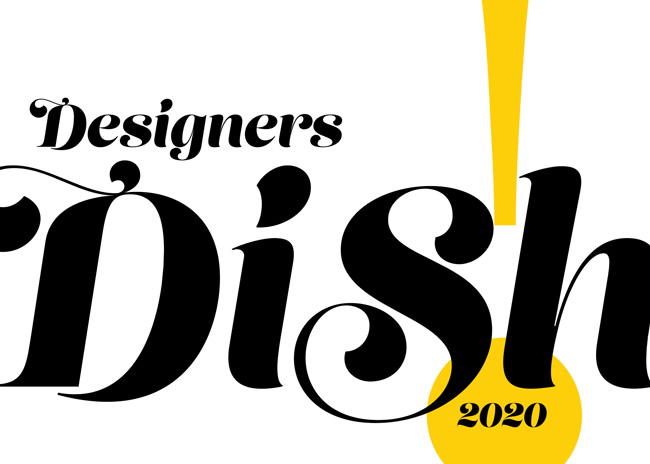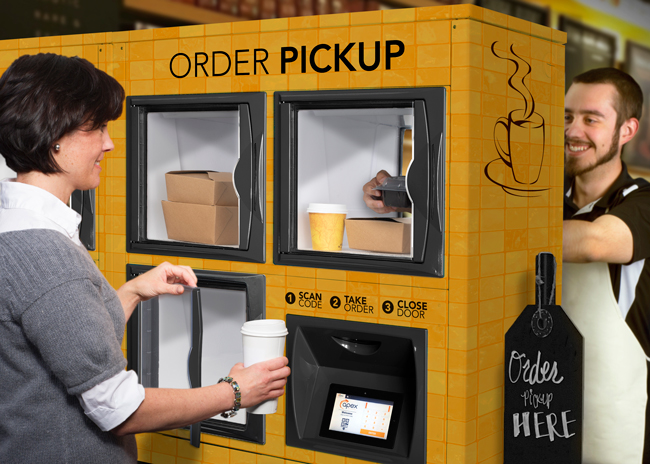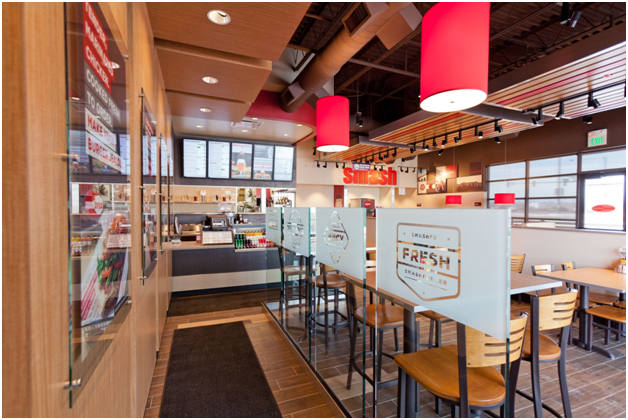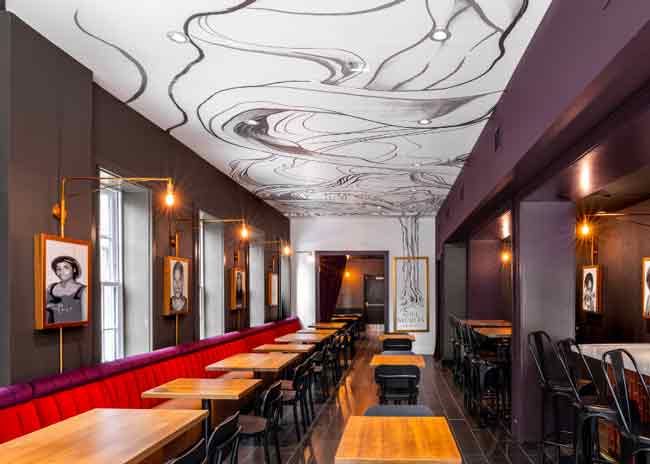Ever wish you could pull up a chair with a few restaurant designers over cocktails to chew the fat about what’s in, what’s out, what inspires them, how they handle tough client issues and what they see coming around the bend? Us too. That’s why, each spring, we recruit a select group of designers from around the country and invite them to dish on a range of topics, gathering and sharing their insights, experiences and advice for rd+d’s annual Designers Dish!
Our 2020 participants represent diverse studios in diverse geographies, but they express similar viewpoints on many big issues facing designers and the industry at large. Big concerns included the dwindling economic viability of independent, chef-driven restaurants in many metro markets; the steady march of technology and its impact on the restaurant experience; the growth of nontraditional competitive segments; and increasingly unrealistic client expectations for project timelines and budgets. They’re also excited about opportunities to nurture the next generation of talent and to help shape the restaurant of the future, be it tech-heavy and built for speed, exceptionally eco-friendly and sustainable, or simply a comfortable, inviting respite in which consumers can unplug and unwind over good food and drinks.
Grab a chair and read on for insights and inspiration from Justin Alpert, AIA, NCARB, Phase Zero Design; Lauren Chipman, CEO & Principal, Chipman Design Architecture; Larah Moravek, partner, Dutch East Design; and Steve Starr, AIA, FSCI, starrdesign. Cocktails optional.
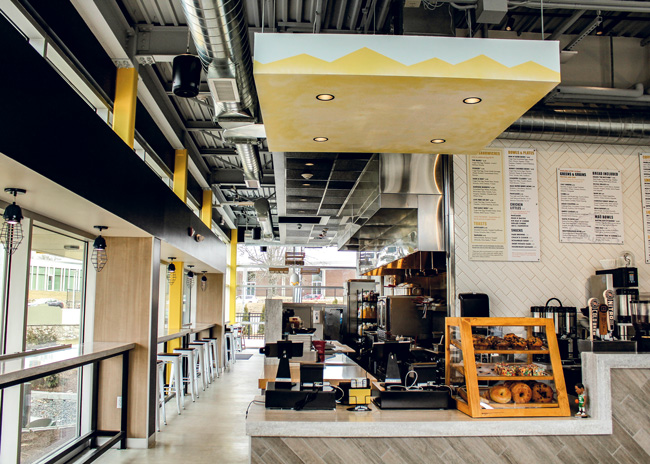 At CRACK’d Kitchen in Andover, Mass., Phase Zero transformed a small, narrow pad site with glass on three sides into an open, fully transparent expression of the quick-casual brand. Image courtesy of Anthony Umbrianna
At CRACK’d Kitchen in Andover, Mass., Phase Zero transformed a small, narrow pad site with glass on three sides into an open, fully transparent expression of the quick-casual brand. Image courtesy of Anthony Umbrianna
What top consumer trends are impacting how you’re thinking about restaurants and design today?
Starr: A few years ago, everything was about food sourcing, farm-to-table, locally sourced — we refer to it as food provenance. Now, that’s becoming simply an entry point: If you’re using fake food, you’re in trouble. Consumers want authenticity and transparency. Operationally, we’re increasingly focused on designing for cook-to-order foods. It’s a movement toward cook, chill, retherm, with the retherm step being the food theater. The old-fashioned way of doing things is being showcased in the expo kitchen, but in the back, there’s a high-tech production kitchen.
Moravek: We’re also seeing a much stronger desire on the part of consumers than in the past to see what’s behind the curtain. The process has become a front-of-house-facing experience. Some other major shifts include fewer people drinking alcohol, with menus and pairings shifting to include nonalcoholic options, and the growth of plant-based menus. On the operator side, we’re also seeing some chefs wanting to offer seating for both a la carte and prix fixe menus. It’s a win for consumers, who have access to a wider breadth of experience, but it puts a heavy load on the kitchen.
Alpert: Restaurants aren’t just competing against each other but also against places like grocery and convenience stores, which have greatly expanded their foodservice offerings, and against food trucks and other nontraditional venues. It’s a trend that highlights consumers’ growing demand for options that are quicker and more convenient than just standing in line in fast-casual restaurants. We’re seeing restaurants respond by reducing their footprints and maximizing their use of technology, particularly mobile ordering and pick-up, all of which needs to be designed into the spaces.
Chipman: Consumers are becoming more aware of what they’re spending their money on and are looking for quality experiences. That doesn’t mean it has to be expensive, but they want to feel the quality in what they’re eating and a connection to the brand. And we think a lot about why consumers are going out to restaurants versus ordering in or cooking at home. It’s about experience and person-to-person interaction, and that’s where we see a lot of smaller, up-and-comer brands succeeding. They have a story to tell, and they’re using their team members and their environments to tell that story. We are in a world where everything is so much more transparent and in which consumers can choose their experience. They can order coffee remotely, pick it up and not have to interact with anyone. But at the same time there’s demand for the polar opposite of that, where they want to feel good about how a brand spends its money, how they treat team members, how they positively affect the community.
 Justin Alpert
Justin Alpert
- Based in: Boston
- Years in restaurant design: 19 in architecture, 11 designing restaurants
- Current material obsession: Mural paint
- Last big tech investment my firm made:
Upgrading the full staff to touchscreen/stylus laptops - Best book read recently: An Architect’s
Cookbook: A Culinary Journey Through
Design by Glen Coben - Favorite podcast: The Garnish
- Morning routine in three words: Tie, jeans, Vans
- Favorite stress reducer: Emo/pop punk club shows
- Other dream job: Restaurateur
What’s happening on the economic side of the ledger?
Starr: The whole development cycle is taking significantly longer. Most of that has to do with finding real estate but getting things in budget is also increasingly difficult. The macro-economic climate is such that everything has increased in price. The cost of materials and labor has risen faster than consumer spending. That’s become a much bigger issue across the board and it’s slowing everything down. There’s still a lot of stuff happening, it’s just taking longer than ever. And for all the stock market growth, clients are being much more cautious now than prerecession.
Moravek: Rents are definitely a huge issue. And tying back to both the plant-based foods and alcohol-free beverage trends, both may have long-term implications for overall restaurant revenues. Menu prices for those items are typically lower than for more traditional items and as consumer preferences continue to shift project budgets may be impacted.
Alpert: Consumer demands for speed and convenience play right into the economic side, along with the increases we’re seeing in minimum wages around the country. As a result, a lot of restaurants are going to smaller spaces that enable them to pay less rent and they’re hiring fewer skilled employees. I believe we’ll see more of this trend going forward as the industry and these critical cost factors continue to shift.
Chipman: Everything is getting more expensive and we do see the economy slowing down a bit. When people are making decisions with their wallet, it’s even more important that they don’t feel like they’re getting ripped off paying $14 for a lunch bowl. Quality has to be imbued within every single part of the experience, from physical environment to ingredients and presentation to sustainability efforts. It will be interesting to see what happens in the next downturn, if some of the more expensive fast-casual chains can sustain their momentum and if the fast-food players can create that fast-casual experience more economically.
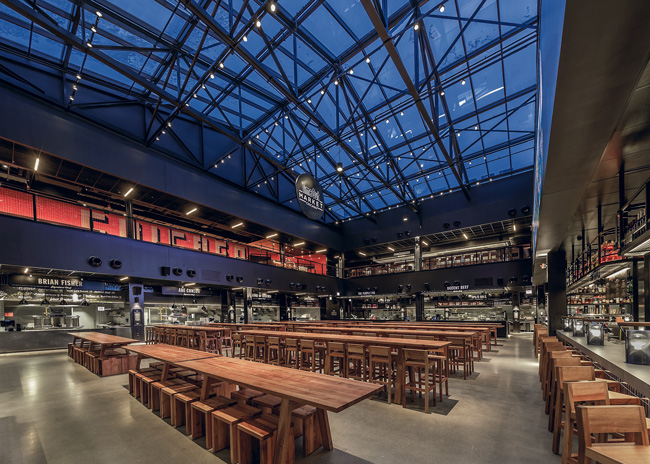 Challenged with creating human scale in the soaring Time Out Market Chicago, Chipman integrated varied seating areas, from communal tables in the large atrium to more intimate options upstairs and in separate bar venues. Image courtesy of Ballogg Photography
Challenged with creating human scale in the soaring Time Out Market Chicago, Chipman integrated varied seating areas, from communal tables in the large atrium to more intimate options upstairs and in separate bar venues. Image courtesy of Ballogg Photography
Is there a trend impacting restaurant design or development that troubles you most?
Starr: Yes, and it’s technology that takes the place of human interaction instead of technology that reinforces and enhances human interaction. To me, replacing human interaction with kiosks and mobile apps isn’t what a restaurant should be. I believe the important role that restaurants play in society is needed today more than ever. Think about it: There are places where regulars come several times a week for breakfast in part because it’s an opportunity for socialization, even if it’s just talking with the cashier. The biggest health epidemic in the U.S. today isn’t cancer or addiction, it’s loneliness. This is a turning point for the restaurant industry. Either we accept that challenge and say restaurants are and will always be a place for human interaction and then there’s a separate thing called a fancy, high-tech vending machine, or we don’t and we go down a path to the dark side.
Moravek: It’s devastating to see entrepreneurs and restaurateurs who have created their first brick-and-mortar be unable to survive beyond a couple of years because rents and other costs are so high. Their quality and service are on point, but independent owner-operators are a dying breed, at least in the New York City market. More and more, everything gets distilled and generalized and there’s less opportunity for those unique gems because there’s just so much at risk.
Alpert: Rising rents gets my vote, too. In our Boston market, we’re seeing restaurants have their five- or seven-year leases come up for renewal and they simply can’t afford to re-up. Many really good restaurants with established teams have closed down and it’s mostly due to rising rents. This may not be as big an issue in smaller markets, but it’s certainly an issue in larger cities. If these entrepreneurs aren’t able to survive, doors just keep opening for large corporate chains to come in and that’s what we’ll be left with.
Chipman: Hollow Instagram food and design experiences! They’re probably not going away any time soon, but over-the-top, unicorn features that don’t add anything to the experience increasingly bother me. I’ve seen it done very successfully in certain restaurants, but a lot of people are just slapping something goofy up on a wall that’s provocative but doesn’t mean anything.
 Lauren Chipman
Lauren Chipman
- Based in: Chicago
- Years in restaurant design: 5 (plus a lifetime in and around the family business)
- Current material obsession: Tile, especially utilitarian, non-sexy tile being applied in interesting ways to create dynamic, big-bang-for-your-buck installations
- Last big tech investment my firm made:
A second point cloud 3D laser scanner for accurately scanning as-built spaces - Best book read recently: The Women of Sea Island by Lisa See
- Favorite podcast: The Daily
- Morning routine in three words: Coffee, run, fashion
- Favorite stress reducer: Meal planning, grocery shopping and cooking
- Other dream job: Kidding, but not really…a professional puzzle
How about a trend that you’re excited about?
Starr: The growing acceptance of ethnic foods, fusion cuisine and people’s willingness to try new things is a very exciting bright spot. To illustrate, we’re doing a taco concept right now that’s not even Mexican. It’s anything you can put in a tortilla. It’s fresh and new, and people are ready for that.
Moravek: We’re all upping our palates and our discernment of quality both in terms of cuisine and design. That’s really exciting, because the bar is being raised all around us and we all benefit. Restaurants no longer need to hang their hats on just on being an institution or a known name. There’s a lot of opportunity to succeed with new and fresh approaches.
Alpert: If we look back 20 or 30 years, most restaurants were run by white, straight, male chefs and owners. But today, we see far greater diversity of people, food and experiences. There’s still a ways to go, but we’ve made huge strides and women, LGBT and minority chefs and restaurateurs now have more respect and more opportunities within the industry.
Chipman: I’m loving restrooms designed as moments of discovery, that leave an indelible mark on the overall guest experience. I visited a highly rated restaurant in San Diego that had recordings playing in the restroom of employees reading bad Yelp reviews. It was such a fun, tongue-in-cheek experience. It created this moment of excitement and a memory that still makes me smile. And not to contradict my previous answer about Instagram, but people do love to take selfies in the bathroom. So, we’re seeing a lot of opportunities to extend the brand and create fun moments of discovery there.
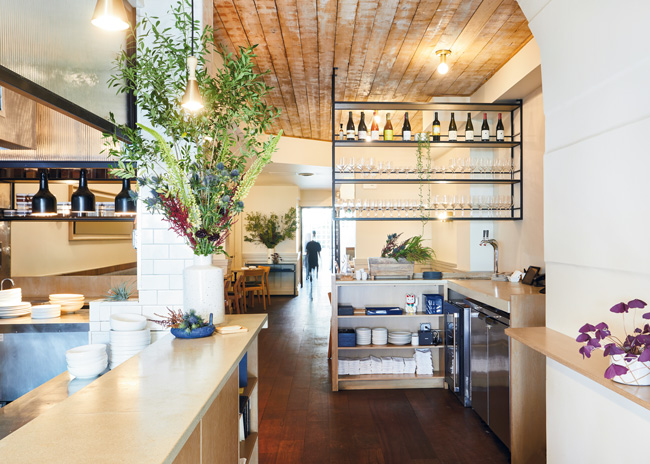 In designing Oxalis, Dutch East started with a long, narrow space with kitchen already positioned just inside the entry. With no budget to move it, they made it the front-of-house hero while a small bar sits in an enclosed back patio. Image courtesy of Jessie English
In designing Oxalis, Dutch East started with a long, narrow space with kitchen already positioned just inside the entry. With no budget to move it, they made it the front-of-house hero while a small bar sits in an enclosed back patio. Image courtesy of Jessie English
In design/build projects, where do clients seem to have the least realistic expectations?
Starr: Time and money. We move very fast but we hear comments like, ‘We said yesterday that we wanted to add a second floor. Why isn’t it done yet?’ We can do it fast but not instantly. And there’s tension between rising costs and the need for significant and strong ROI. That equation is getting harder to balance. Because there’s more competition, there’s a need to do things that are remarkable and memorable to drive traffic and get average unit volumes and ROI up, but a lot of clients are more hesitant than in the past to make the bigger investments required to be remarkable. So, at what point do you just go backwards and address the least common denominator? Intellectually, everyone gets it but when it comes to actually doing it, they’re hesitant. It’s something we go around in circles about.
Moravek: We have a mixed bag of clients, some quite experienced and some first-time restaurateurs. But across the board, there’s a glaring gap between expectations and reality on both time and budget. They want things yesterday, and they want everything at the lowest cost. And soft costs are especially tough — allowing for all of the consultants and third parties that need to be involved. If there are structural issues, they need to get an engineer on board. And there are costs involved with permitting. They may not see them in the forefront of what needs to be accounted for and paid for, but they’re crucial.
Alpert: Cost of construction and time for actually doing the desired documentation. We’ve had clients look up prices of finishes and materials and come to us and say, ‘Well, construction should only cost this.’ Unfortunately, it doesn’t work that way. And I’ve had some say, ‘How long is it going to take you to draw up these plans?’ There’s a lack of understanding of the full process and what the designers, architects and engineers need to do to help ensure their projects are successful.
Chipman: Schedules and timelines are our biggest challenge, as well. Everyone wants to get to market faster than the guy next door and all phases of projects are being shrunk down as much as possible. Ultimately, nobody’s winning because they’re not allowing enough time for the entire process to take place as it needs to.
 Larah Moravek
Larah Moravek
- Based in: New York City
- Years in restaurant design: 20
- Current material obsessions: Glazed brick tile and brick pavers
- Last big tech investment my firm made:
Server upgrade - Best book read recently: All These Wonders: True Stories About Facing the Unknown by Catherine Burns
- Favorite podcast: On Being
- Morning routine in three words: Slow and steady. I need to ease into my day.
- Favorite stress reducer: Get outside, play with my dog, go for a walk — anything to shift the physical parameters so I can rebalance
- Other dream job: Astronaut, or working on an animal preserve
What strategies do you use to try to manage such expectations?
Starr: Frequent and consistent communication. And we find that we have to be much more explicit with explaining our process: ‘This is why we’re meeting. This is what we’re going to show you. We need your feedback on these three items and your comments or approval on these five other items.’ Things are much more fluid now, so we have to respond and provide more structure than even just two or three years ago. We come to the table setting the objectives, setting the schedule, keeping everyone on track and being very direct about saying ‘this is what we need from you right now in order for us to deliver what you need.’
Moravek: Particularly for newer operators, we focus a lot on education about the process, walking them through all of the various steps and trades involved and showing them how difficult and costly it can be to get things done. We ask a lot of questions and, in a way, set them up to think about if they’re really ready for this. Sometimes we lose those projects, but we’d rather be able to do them properly than have them not be productive for all parties. We also try to get them to think longer term. If they’re pushing for the most budget-conscious chair, we’ll do an analysis and let them know that they can buy that chair now and replace it in a year or two or spend a little more now for a chair that will last 10 years. There are ways to try and open the door and show a different way of attacking the process.
Alpert: Even before we sign any contracts, I walk them through each of the phases, from schematic design through construction administration, what the architects’ and engineers’ roles are and the coordination needed with their consultants. The more that they can understand about the effort that goes into it, the more they’ll understand the timeline that’s required and the cost of hiring professionals.
Chipman: In part, we look for opportunities to compress the schedule without negatively impacting the quality of the drawings, the design or construction. One approach is to bring the GC on as soon as possible and create a collaborative relationship between owner, architect/designer and contractor so we can find scheduling efficiencies. We can avoid a round of value engineering, for instance, because we can price things out earlier and find some creative work arounds without affecting the quality of the project.
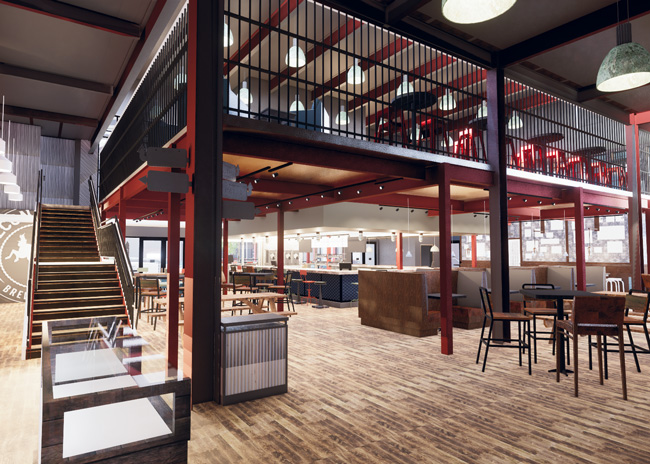 After completing much of the design work for a large food, drink and entertainment venue, starrdesign was asked to add private event space. The studio complied by building a 3,000-square-foot second story over the bar. Rendering courtesy of starrdesign
After completing much of the design work for a large food, drink and entertainment venue, starrdesign was asked to add private event space. The studio complied by building a 3,000-square-foot second story over the bar. Rendering courtesy of starrdesign
Give us an example of creative problem solving through design from a recent restaurant project.
Starr: We’re working on large food, beverage and entertainment venue in Fort Worth, Texas. It includes indoor bar, brewery and a large yard with two food venues attached to it. The yard has a retractable roof and there are big retractable doors that open onto a patio. There was a lot of problem solving required. How do you make the yard a great atmosphere when the roof is open or closed? How do you prevent a greenhouse effect? A lot of technical things related to how customers would experience the space and how operations would work came into play. One of the biggest was the owner’s desire for a private event space. We looked at three or four different options, including a mezzanine inside the brewery, but we ended up building a second story for it above the indoor bar area instead. Operations was a big factor impacting that decision, as was cost. It’s significantly more expensive to add a 3,000-square-foot second floor than a mezzanine, but when we analyzed potential ROI, the right move was to build a second floor.
Moravek: At Oxalis in Brooklyn, N.Y., Chef Nicco Russell took over an existing long and narrow space that had the kitchen positioned right in front. It created a difficult operational problem and the space had some unique physical limitations. Our approach was to make the kitchen the hero and have it very accessible. You experience the kitchen right upon entering, while the bar is in an enclosed back patio. We also often come into raw spaces where the physical parameters don’t work that well for a restaurant — they’re sterile with plain storefront facades and high, exposed ceilings. In such spaces, a strategy we like is to cover the ceiling in a very bold or dark color or material. It changes the human scale within the space and brings down one sight line.
Alpert: We recently designed a CRACK’d Kitchen in Andover, Mass. It was a pad site, very small and narrow with glass on three sides. Anyway, the back of house was blocking a lot of the exterior windows and squeezing the customer space. Our solution was to make it as open as possible. With the exception of a walk-in cooler, a few shelves and a small dish area, everything is exposed — full cook line, prep area, etc. There are still a few tight spots, but because of how open it is and because of the colors and natural light in the space, we were able to achieve something that feels good in a really small space.
Chipman: We did architecture and interior design for the new Time Out Market Chicago food and entertainment hall. The building is 50,000 square feet over three floors with a giant atrium. A big challenge was to create intimate moments and not have guests feel overwhelmed by its massive scale. We designed a variety of seating opportunities within the space. The atrium is all communal seating. It’s loud, exciting and fun. On the second floor, we have casual bleacher seating near a giant video wall. But we also created zones on the exterior of the ground floor and second floor to provide moments of intimacy. Around the corner from the bleacher seating, there’s very private seating where you could have a meeting or a date. On that floor we also have a more intimate speakeasy bar and the third floor is designed as a year-round rooftop experience. There’s a much smaller scale bar there and an outdoor beer garden ambiance that opens up when the weather is nice.
 Steve Starr
Steve Starr
- Based in: Charlotte, N.C.
- Years in restaurant design: 29
- Current material obsessions: Cuttable/paintable acoustical panels, denim, linoleum
- Last big tech investment my firm made: Premium video conference system, project collaboration software, accounting system that provides all team members with full transparency into company (except salaries) and project financials.
- Best book read recently: Radical Candor by Kim Scott
- Favorite podcast: TED Talks
- Morning routine in three words: Coffee, coffee, coffee
- Favorite stress reducer: Cooking
- Other dream job: High school football coach
The year 2020 feels like a good time to look ahead. Give us your predictive vision for the “restaurant of the future.”
Starr: I think there’s going to be a separation between very experience- and socially-driven restaurants and convenience-driven, glorified vending machines. The latter will be super-automated and are probably going to become more prevalent, like the ghost kitchen idea where delivery is coming out of a separate production kitchen. Or if that production kitchen is within the restaurant, it will be designed so that it enhances, or at least doesn’t detract from, the on-site guest experience. I also think ghost kitchens will be mobile in some way — big, semi-trailer things. Not food trucks, but mobile kitchens that can go where needed and react accordingly.
Moravek: My hope is that restaurants of the future continue to evolve to go back to the basics of simple, genuine, human service, good food, un-themed, honest and raw experiences. It seems anymore that we all can get so overstimulated, and sometimes just want a good meal and a place to relax and unplug. Restaurants can be a respite, and we need that.
Alpert: We’re going to see increased use of technology everywhere, but at some point we’re going to be overly inundated with it. I’m hoping that restaurants once again become that place where family and friends can go to disconnect, eat, debate, laugh and just hang out. I’m seeing some very high-tech restaurants coming out, but my feeling is we’ll get to a point where everyone’s just going to want some soft seating, a good meal and a place to relax for a while. We’ll be designing the spaces accordingly.
Chipman: I can’t overstate the importance of climate change and the environment when looking toward the future. It’s been exciting to see plant-based burgers take hold in mainstream markets, and the advent of movements like Veganuary in efforts to get Americans to eat more sustainably. If we’re taking climate change seriously and doing something about it, it won’t just be the restaurant of the future, but the lifestyle of the future that will need to change. In a perfect world, everyone would start taking sustainability more seriously and work to correct some of the mistakes of the past. What would a McDonald’s look like if everything isn’t going into a landfill, or when we’re sustainably farming and really taking care of this planet? And how would that be reflected in the day-to-day not only of the customers but of the team member, the brand, its farmers and suppliers? I envision restaurants of the future tackling these questions much more seriously and all of us bringing innovative sustainability solutions to market.

